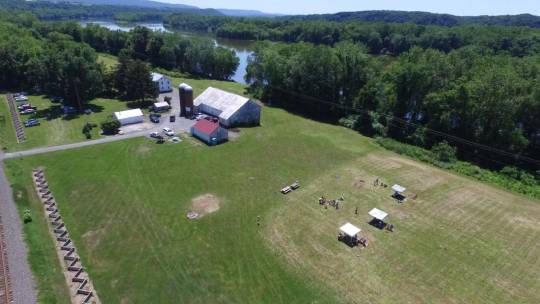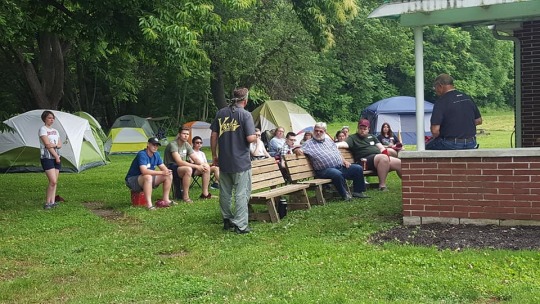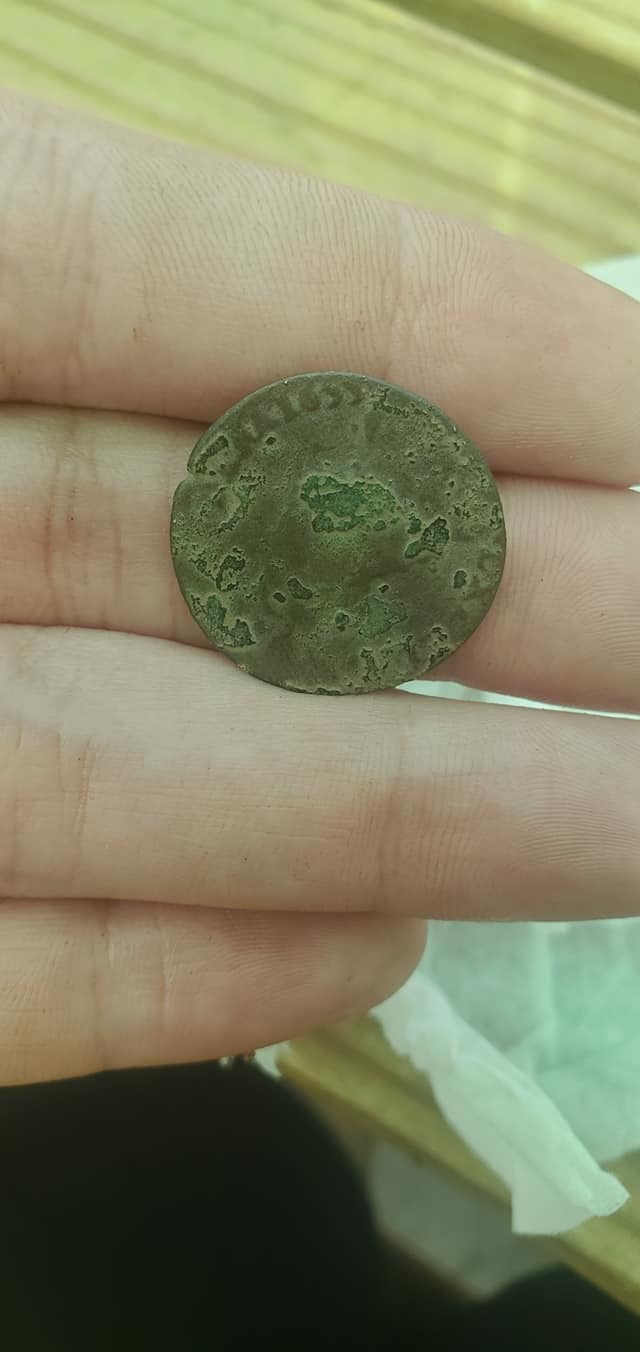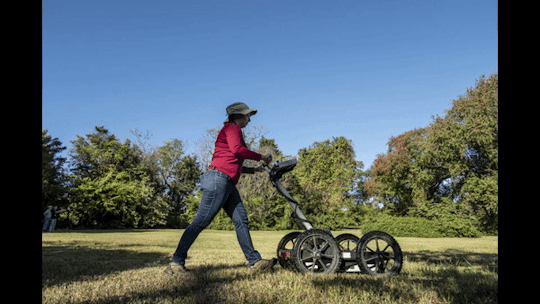Video
0 notes
Text
Fort Halifax, Pennsylvania

Fort Halifax Park is located in Halifax, Pennsylvania in Dauphin County. The fort was part of three fortifications built along the Susquehanna River. Fort Hunter and Fort Augusta were the other two forts. The forts were built to protect settlers from raids from French and Indian War parties. Fort Halifax was built in 1756 from wood from the local Armstrong Sawmill. The Fort was then dismantled in 1757 with the supplies moved down river and the garrison moved to Fort Hunter.
In June of 2021, Juniata College Archaeology held a field school at Fort Halifax Park. The main point of the field school was to find the original “footprint” of the fort. GPR (Ground-penetrating Radar) was done earlier in the year by Dickinson College to find features in the ground but it did not find major fort features.

When we arrived on Sunday, we set up Tent City, as we liked to call it, and proceeded to learn about what we were going to be doing. We also received our tools that we would be using in the field. They consisted of a scoop, a towel, a sharpener for the trowel, a meter tape measure, and a clip board that we could put our paper work in. We camped in our tents for 2 weeks and had to use 5 gallon Camp Showers as our showers and porta potties for the bathroom. The one thing that sucked about camping, was the train that came through the park throughout the day, and throughout the night ( https://youtube.com/shorts/smd3rc5FG-E ).
The conditions weren’t great but we were enthusiastic anyway. Our motto for the next two weeks became: “Find the Fort!”

We went into the field the next morning starting at 8:30am. Every morning we would get up and have breakfast before we headed out into the field at the same time every day. We would then be digging in the field until we broke for lunch around 12:30ish. After lunch we would head back into the field to dig until 5:00-5:30pm. The days were hot, humid, and muggy and having no trees in the field was not fun either. The only shade we had was under the pop up canopies we could put up, if we were lucky. We were covered in dirt, sun screen, and bug spray every single day. All of our clothes were caked in mud. While digging and starting to find artifacts, one of our field helpers who specializes in lithics told us that whoever found the first projectile point, gets a 6-pack. Someone did find one, but unfortunately for them, they were under 21. (This is not the point)


One day we dug a trench that was 5 or 6 units long. We paired up and got to dig our own unit and eventually we all got to get in to dig. (We made a much deeper and wider trench later on). We would take all of the dirt out of the unit and put it in big buckets and then put the dirt into screens to sift through them to find artifacts. Most people had preferences of whether they wanted to dig or screen.

We would have at least 3 to 4 units being dug at a time with 3 to 4 people at each site. This is so we could try to find features faster. All while we were digging, people were in the entire field metal detecting. Anytime someone found something while metal detecting, they would put it in a bag and flag it where the hole was. The field soon became covered in different colored flags. We were finding pre-historic artifacts and historic artifacts. Lots of nails, too. Our goal was to dig through the plow zone to get to the next color change in the soil to see if there were any features. (Below, 1655 French Liard from metal detecting)

We found lots of artifacts while working and everyday, two people would go to the house by Tent City to work on cleaning artifacts with retired archaeologist, Joe Baker. We had hundreds of artifacts and so many bags to go through and catalog. One morning, it rained all day so we stayed at the house and worked on cleaning artifacts all day long. We had a ton of trays lined up inside to dry.

In total, we ended up opening 53 test units in 2 weeks. And on the second to last day, we found the fort. A group had a 2x2 test unit open (4 units all together) and they found the corner of the fort. Our unit beside them found the wall that then ran into the 2x2 unit. Of course we found the fort on basically the last day.



Even with having to camp in a tent for 2 weeks in the hot June, almost July, weather, and with no proper bathrooms/showers, and with the train coming through, I still had a great experience during this field school. It showed me what I could do with my degree and what many people do as a career in archaeology. I met tons of new people and made a lot of new friends. Would I do this again? Probably not. Maybe with the right conditions. But it was still a fantastic experience and I will never forget it.
1 note
·
View note
Text
Humans in the Americas Earlier than we Believed

For years, there has been an ongoing debate about when humans migrated to North America. As children in Elementary school we were taught that humans migrated into Alaska from Asia using the Bering Strait Land Bridge.
But recently, archaeologists have discovered fossilized human footprints in New Mexico. These footprints would date back to the Last Glacial Maximum which would be 5,000 years earlier than we had originally believed humans arrived. The footprints are around 21,000-23,000 years old.
When looking at stone tools or bones, they can move in the soil layers, moving from their original place, but with these footprints, they’re in fixed positions and cannot move from their original place. This helps archaeologists measure them and figure out who might’ve left them, which in this case, archaeologists believe they were left by children and teenagers. Children and teenagers were involved in more simple labor tasks like gathering food, water, and raw materials and also playing and doing chores. The footprints provide details of day to day activities of our ancestors.
Archaeologists have always debated about when humans first arrived in the Americas and few of them see reliable evidence for sites that are older than 16,000 years. But some think that the arrival was around 13,000 years ago by looking at artifacts from the Clovis culture. They made projectile points in a specific way that is different from other early human cultures.
The discovery of the footprints is helping us learn more about early human migration and helping us learn about what happened after they arrived earlier than we thought in North America.
0 notes
Text
The Discovery of Endurance

Archaeologists in the Weddell Sea in Antarctica have discovered the lost ship, Endurance. The ship had sank in 1915 during an expedition led by Ernest Shackleton. The ship was found 9,869 feet under the Weddell Sea by archaeologists using underwater vehicles. These vehicles can be used on a tether or autonomously, which is how they were used for this discovery. The ship had become famous due to the famous pictures of it stuck in the ice and sinking and due to the journal published that was written during the survival of the crew.
The ship is very well preserved for being a wooden ship underwater. The cold temperatures have kept it in a great state of preservation for all these years. The area the ship was found in is a few hundred miles off the coast of Antarctica and usually covered in ice. Ice, cold temperatures, and blizzards had an impact on efforts for past discoveries, making crews turn back.
Shackleton wanted to complete the first complete crossing of Antarctica by dog sled and the Endurance was supposed to take the team to the southern coast of the Weddell Sea but it became trapped in the ice. The team made camp on the ice with their supplies from the boat. Eventually they tried to reach land by dog sled but had to then resort to lifeboats from the ship that they had obtained before it sank. They reached land at Elephant Island and fortunately, all 28 crew members survived.
0 notes
Photo

I emailed a few Archaeologists to ask them a few questions about their careers in Archaeology and their experiences in the field. Each Archaeologist were asked the same questions.
———————————————————————————————————–
Nadia Johnson is an archaeologist who works for Rhea Engineers and Consultants INC. She has also worked at Penn State University and the University of Pittsburgh at Greensburg as an instructor of Anthropology. She has been a field technician on many different projects and likes to work on field projects with her father.
Why is archaeology important to you?
It's important to me to feel connected to the world that I live in, including the people who came before me. I was drawn to archaeology because I'm endlessly curious about the past, but now that I'm in it, I feel a tremendous responsibility to be a good steward and to be a conscientious collaborator with descendant groups. It's a lot of pressure, but I feel like it's worth the effort.
What got you in to archaeology?
I grew up in a family full of history and archaeology nerds. My dad is a geologist, but he has always been obsessed with archaeology. He took up archaeological geophysics as a hobby, and when I was a kid, I would tag along on a lot of his projects, looking for old graves, building foundations, and even once unexploded ordnance at a WWII POW camp. I got to meet his archaeologist friends, read all his archaeology magazines, and share this obsession with him. Every vacation we took included some important historical or archaeological site, and my parents encouraged my interest every step of the way. By the time I was in college, I wasn't really planning on archaeology as a specialization, but I figured that I owed it to myself to give it a shot, so I signed up for a field school in Wisconsin, had the time of my life excavating a Mississippian site there, and my mind was made up.
How many years have you been working in the field?
Not counting my childhood adventures in archaeological geophysics, I did my field school in 2010 (my freshman year of college), and got my first paying gig in archaeology the summer after that. So, 11 years?
What is your favorite site you've worked on or favorite site to research?
Teotihuacan, definitely. It feels like a bit of a cop-out answer because it's such a huge, famous site, with pyramids and massive monumental art and architecture, and it gets a lot of attention. All that aside, I am genuinely fascinated by the site. More than any other topic, I'm interested in the mechanisms of early state formation and human-environment interaction, and Teotihuacan is such a great place to look at those things. Even more than that, though, it was working in the Teotihuacan Valley that I really started to feel like an archaeologist. I got to live and work in this great lab with a bunch of incredible people. I fell in love with Mexico and the town of San Juan Teotihuacan. I got to know the folks that worked at my favorite restaurants, I got invited out to peoples' farms and villages for birthday or saint's day parties, and it was just a transformative experience.
Where do you currently work or have worked in the field?
Since I'm not focusing on research right now, I don't have a particular site or region of interest anymore, although Central Mexico will always have my heart. My current work mostly takes me around PA and sometimes into WV, OH, and VA, but who knows where it will take me in the future. Before settling down into my cultural resource management job, I had worked at the site of Trempealeau in Wisconsin, and the sites of Tepeticpac, Tlaxcala; Altica, Edo. Mexico; and Teotihuacan, Edo. Mexico. My lab work has involved materials from Guatemala and around Mexico.
What is your favorite moment of your career?
I'm not sure that I have one! I have my most interesting finds (an imported jade bead in the mouth of a burial at Altica); the moment that I felt most connected to the past inhabitants of the site (finding two flakes of a broken hoe that re-fit perfectly at Trempealeau); but most of my favorite memories are of times that I spent with my friends and colleagues. Spending 13 hours in the lab sorting tiny pieces of obsidian is much more fun when you have friends to joke around with. A day spent pushing heavy equipment back and forth across a parking lot is more fun when you get to hang out with your dad and share those moments together.
What are your plans for the future (sites, work, etc)?
I hope to get more opportunities to work in archaeological geophysics. It's a skillset that I've been working hard to grow lately, and I'm hoping to have some chances in the near future to do some geophysics at a handful of Revolutionary War era cemeteries in Virginia. It's tough to predict how work will come and go in CRM, especially working for a small company, but I'm trying to expand my reach a little bit, and I'm looking forward to seeing where the future is going to take me
0 notes
Photo

I emailed a few Archaeologists to ask them a few questions about their careers in Archaeology and their experiences in the field. Each Archaeologist were asked the same questions.
———————————————————————————————————–
Elizabeth Arkush is an archaeologist and a professor at the University of Pittsburgh. She has worked in the field in Peru since 1999, researching war and violence in the Peruvian Andes. She currently teaches several classes at Pitt and has written many publications.
Why is archaeology important to you?
I think it gives us valuable perspective on our time now, especially for checking our perceptions of what's "normal." It also tells us a great deal that's valuable about humanity - who we are and what we do as these fascinating, complicated social animals, and where we have come from.
What got you in to archaeology?
I've always been interested in archaeology for as long as I can remember. When I was little I would dig in my backyard to see what I could find. After college (I was a Classics major), I took a continuing ed course about Andean archaeology from a fantastic professor, and that got me into the Andes in particular.
How many years have you been working in the field?
About 25 years
What is your favorite site you've worked on or favorite site to research?
Early in my grad school years, I was helping out on a project in the Peruvian Titicaca basin, and I got curious about Pucarani, a huge hillfort site we would drive by on our way to work at another site. One weekend I hiked up it with a friend. That experience got me hooked on hillforts, which I have spent a lot of time researching in the years since. A few years ago I was lucky enough to get a grant to go back to Pucarani and document the architecture more fully, collaborating with Pitt PhD Hugo Ikehara as my co-director. It is a huge pain to hike up to, but it's an incredible site and holds a special meaning for me.
Where do you currently work or have worked in the field?
Nowhere during the Covid pandemic. Through my career I have worked in Peru. During the last 2 years of Covid when fieldwork was not possible, I've been analyzing and publishing back material and working on a project that can be done remotely with satellite imagery.
What is your favorite moment of your career?
Probably just the many good times I've had with friends, students and crew members on field projects. But here is a funny moment for you: I was doing my dissertation research and had taken samples of mortar from the defensive walls of some of the hillforts, since there was often grass embedded in the mortar that could be carbon-dated. I was picking through a sample in the lab with sterilized tools to get the grass out, and I realized in frustration that one of my hairs had fallen on the lab table and gotten into the sample, potentially contaminating it. Then I saw that the other end of the hair was embedded in a solid chunk of mortar. It wasn't my hair; it was the hair of a person who had built that wall about 700 years ago.
What are your plans for the future (sites, work, etc)?
Getting back to Peru this summer!
0 notes
Photo

I emailed a few Archaeologists to ask them a few questions about their careers in Archaeology and their experiences in the field. Each Archaeologist were asked the same questions.
-----------------------------------------------------------------------------------------------------------
Joe Baker is a retired archaeologists who has worked at PennDOT, the Pennsylvania Historical and Museum Commission, and with Preservation Pennsylvania. He graduated from Penn State with a Bachelor of Arts in Anthropology and then graduated from the University of Montana with a Masters degree in Anthropology. He has worked on many archaeological projects throughout his career. He retired in 2019 but still enjoys working in the field on projects.
Why is archaeology important to you?
To me, archaeology is a source of real, factual information about how our species has interacted with the world around us and with each other. It’s an opportunity to learn and to prepare for the future.
What got you in to archaeology?
I had a series of great and gifted teachers, starting in High School history class.
How many years have you been working in the field?
My first paying job as an archaeologist was in 1979, so 42 years and counting.
What is your favorite site you've worked on or favorite site to research?
Forty-two years means lots of sites, and lots of them were amazing. My current favorite is probably Fort Halifax.
Where do you currently work or have worked in the field?
Right now in Pennsylvania, but I’ve done projects in Montana, Wyoming, Maryland, Virginia, and a ton in PA.
What is your favorite moment of your career?
Again, 42 years is a long time, so that’s not an easy question. In 2019, around the time of my retirement from PennDOT, several generations of former interns, employees, and colleagues surprised me at a conference with a composite video of various reminiscences and kindnesses. It made me bawl in public. That was a highlight…
What are your plans for the future (sites, work, etc)?
I want to keep pecking away at Fort Halifax with Dr. Burns, and continue to assist DCNR in launching their first Cultural Resources program. I also want to keep training and mentoring students and young practitioners at the beginnings of their careers.
1 note
·
View note